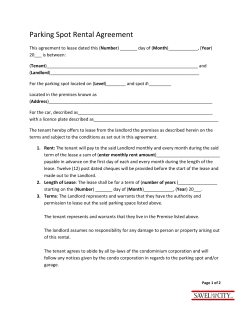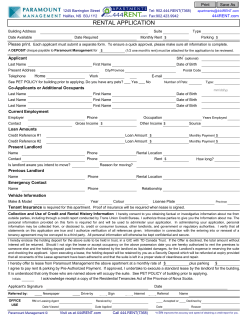
ASSIGNMENT OF COMMERCIAL LEASE (WITH LANDLORD CONSENT) & GUIDE Included:
ASSIGNMENT OF COMMERCIAL LEASE (WITH LANDLORD CONSENT) & GUIDE Included: Overview Dos and Don’ts Checklist Assignment of Commercial Lease (with Landlord Consent) Instructions Sample Assignment of Commercial Lease (with Landlord Consent) © LEGALZOOM.COM, INC. 2008 1. Overview Occasionally, tenants want to leave a rental property before the end of their lease. Individuals may take new jobs in new cities, and companies may go out of business or sell their enterprise to a third party. Whatever the reason, tenants can transfer their lease interests to new parties by completing an assignment of the lease. An assignment is the transfer of one party’s entire interest in and obligations under a lease to another party. The new tenant takes on the lease responsibilities, including rent and property maintenance, and the original tenant is released from most (if not all) of its duties. Successful property management begins with good documentation, and a properly-drafted and executed assignment will ensure that all parties – new and old – understand the obligations that are being transferred and the responsibilities that each will have under the new arrangement. In every way, this lays the foundation for a great (and long-lasting) landlord/new tenant relationship. 2. Dos & Don’ts Checklist An assignment is the complete transfer of one party’s interest in an agreement to a third party. In this case, the original tenant is giving all of his or her interest to a new tenant. That new tenant steps into the shoes of your old tenant, and your old tenant is released from most of his or her obligations under the lease (although this can be changed by agreement). This is not the same as a sublease. Under a sublease, a third party is granted only those specific rights provided in the sublease. The original tenant still remains ultimately liable for residual obligations under the lease, or any failures of the new tenant to meet his or her obligations. This means that the original tenant will be responsible (in equal measure with the new tenant) for any skipped rent payments or damage to the property. Be sure the Assignee gets a copy of the original lease. He or she will be bound by its terms, and should know what his or her new obligations and rights are. A copy should be attached to the Assignment as Exhibit A. The original tenant cannot assign more rights than it has under the original lease. For example, if the term of the lease is 1 year, the term of the assignment cannot be 2 years. Most leases will require the landlord’s written consent before an assignment becomes effective. Review the original lease agreement for additional information, and to see if there are other requirements that must be met to make the transfer valid. Although a landlord is not required to consent to a lease assignment, in some cases your lease will state that a landlord’s consent will not be “unreasonably” withheld. This is more common in commercial leases. What is considered unreasonable varies from jurisdiction to jurisdiction and you should review the laws in your area (and the language in your original lease agreement) for additional information. On the other hand, if the lease states that the landlord may use his or her “sole discretion” to evaluate the new tenant, he or she can veto this assignment without any reason. ASSIGNMENT OF COMMERCIAL LEASE (WITH LANDLORD CONSENT) © LEGALZOOM.COM, INC. 2008 1 Depending on your jurisdiction or the terms of your original lease, a landlord’s failure to respond to your request for consent to assignment within a certain time may itself be deemed consent. In some cases, it may give a tenant grounds to terminate the lease. Review the original lease and your state’s laws for additional details. A landlord may consider only proper factors when deciding whether or not to consent to an assignment. Some criteria will be considered impermissible by courts (e.g., refusal is based on race or sex of the proposed new tenant). If your landlord does not consent to your attempted assignment, make sure he or she gives you clear written reasons for the decision. Failure to provide such reasons can itself be deemed unreasonable. Sign three copies of the assignment, one for you, the other party, and the landlord. Depending on the nature of its terms, you may decide to have the document witnessed or notarized. This will limit later challenges to the validity of a party’s signature. State laws governing real estate, renting, leasing, and assignments vary widely, and can have a tremendous effect on your arrangement. In some cases, specific information must be included in the assignment and in others, language must be excluded form your agreement. Review your state and local laws for additional information about what is required in your area. If your agreement is complicated, do not use the enclosed form. Contact an attorney to help you draft a document that will meet your specific needs. 3. Assignment of Commercial Lease (with Landlord Consent) Instructions The following provision-by-provision instructions will help you understand the terms of your assignment. The numbers below (e.g., Section 1, Section 2, etc.) correspond to provisions in the form. Please review the entire document before starting your step-by-step process. • Introduction. Identifies the document as an assignment of lease. Write in the date on which the assignment will become effective (often the date on which it is signed). Identify the parties and, if applicable, what type of organization(s) they are. Note that each party is given a name (e.g., “Assignor”) that will be used throughout the agreement. The current tenant is called the “Assignor,” because he or she is the person who is assigning the interest. The new tenant is called the “Assignee.” • Recitals. The “whereas” clauses, referred to as recitals, define the world of the agreement and offer key background information about the parties. In this Assignment, the recitals include a simple statement of the parties’ intent to assign the Assignor’s interest in the Lease and the Assignee’s intent to assume it. Provide a brief description of the property being rented, and the name of the landlord under the Lease. Attach a copy of the Lease to the Assignment as Exhibit A. ASSIGNMENT OF COMMERCIAL LEASE (WITH LANDLORD CONSENT) © LEGALZOOM.COM, INC. 2008 2 Describe the property that is being assigned. You don’t need to include a full legal description, but provide enough information so it can be clearly identified. For individual houses, the address will usually be sufficient. If the property has a specific name (e.g., “Lincoln Towers”), include that as well. If only a section of the Premises is being assigned, make that clear in this description. • Section 1: Assignment. The Assignor’s assignment of its right and interest in the Lease to the Assignee. This paragraph allows you to determine whether all of the Assignor’s interest in the Lease is being assigned, or only part of it. For example, if interest in only one half of the Premises is being assigned, this should be clearly noted in the space provided. Delete the bracketed phrase that does not apply to your arrangement. • Section 2: Assumption of Rights and Duties. Provides that the Assignor is no longer responsible for the duties listed under the Lease (e.g., rent, maintenance of property, etc.). There are two options provided regarding the continuing liability of the Assignor. In the first, the Assignor is completely released from any liability it had under the Lease. If the Assignee defaults, for example, the Landlord cannot seek payment from the Assignor. In the second, the Assignor will be liable to the Landlord if the Assignee defaults. Select the option that best suits your arrangement, and delete the other. Note that, in any event, the Assignor will remain responsible for any obligations that occurred before the assignment. In other words, if damage happened to the apartment before the transfer, or if the Assignor did not fulfill another obligation under the Lease, the Assignor remains responsible. • Section 3: Reimbursement. In many rental relationships, amounts are paid in advance or deposited as security for the landlord. At the end of the lease, this money (with deductions subtracted or interest added) is returned to the tenant. If a lease interest is assigned, the lease does not end and the assigning party cannot get this money back. This paragraph requires the Assignee to pay those amounts to the Assignor, and any later return of that money by the Landlord will be made to the Assignee. • Section 4: Indemnification. The Assignee’s promise to bear the financial cost of any injury the Assignor suffers as a result of its assignment, and any lawsuits that may arise from its activities on the Premises. Note that there is an exception carved out for things done by the Assignor before the Effective Date of the Assignment – the Assignor remains responsible for those actions. • Section 5: Continuing Effectiveness of Lease. Emphasizes that except for the assignment, the original terms of the Lease are still effective. • Section 6: Assignor’s Representations and Warranties. Lists the Assignor’s promises under the Assignment. Note that this is not a detailed list of services to be provided. Rather, this is the Assignor’s assurance that the Lease and the rental interest it’s providing is useful (i.e., no one else lives or has an interest in the place, the lease is still in effect, the Assignor is not behind in rental payments, etc.). If there are additional representations you think the Assignor should be making, feel free to include those here. • Section 7: Condition of Premises. Notes that the Premises are not being warranted to be perfect or useful in a particular way. Rather, the Assignee is taking the rented property for what it is, and is accepting it in that state. ASSIGNMENT OF COMMERCIAL LEASE (WITH LANDLORD CONSENT) © LEGALZOOM.COM, INC. 2008 3 • (Optional) Section 8: Additional Terms of Assignment. An optional provision allowing the Assignor and the Assignee to include any representations, warranties, or other provisions particular to their situation. If you remove this section, correct the section numbers and the references in the document. • Section 9: Interpretation. Provides that both Parties were on equal footing in the negotiation of the consent to assignment. In many cases, contracts are interpreted in favor of the individual who did not draft it. This clause makes clear that both Parties were involved in the drafting, and so the document should not be read in favor of (or against) either. • Section 10: Notice. Lists the addresses to which all official or legal correspondence should be delivered. Write in a mailing address for both the Assignor and the Assignee. • Section 11: Modification. Indicates that any changes to the document are ineffective unless they are made in writing and signed by both Parties. • Section 12: Governing Law. Allows the parties to choose the state laws that will be used to interpret the document. Note that this is not a venue provision. The included language will not impact where a potential claim can be brought. Write in the applicable state law in the blanks provided. The governing law will almost always be that of the place where the apartment or rental building is located. It’s generally a bad idea to attempt to use a different location. • Section 13: Counterparts / Electronic Signatures. The title of this provision sounds complicated, but it is simple to explain: it says that even if the Parties sign the Assignment in different locations, or use electronic devices to transmit signatures (e.g., fax machines or computers), all of the separate pieces will be considered part of the same agreement. In a modern world where signing parties are often not in the same city - much less the same room - this provision ensures that business can be transacted efficiently, without sacrificing the validity of the agreement as a whole. • Section 14: Entire Agreement. The Parties’ agreement that the document they’re signing is “the agreement” about the issues involved. Unfortunately, the inclusion of this provision will not prevent a Party from arguing that other enforceable promises exist, but it will provide you some protection from these claims. • Landlord’s Consent [and Release]. Review the terms of the original lease agreement to determine whether or not the Landlord’s consent is required to make the assignment effective. This is usually the case. If so, have the Landlord sign the document in the space provided. Note that there are two options provided at the end of the consent. You may choose only one of these and should delete the one that you do not use. The first option corresponds to the brackets in Section 2 of the Assignment. If the Assignor will remain responsible under the Lease, even after the Assignment, include this first bracketed language in the consent. For example, if the Assignee doesn’t make rent payments, the Landlord will be able to get these payments from the Assignor. Delete the phrase “and Release” from the title of this paragraph if you choose this option. If the Assignor will not be responsible under the Lease, select the second bracketed phrase, which releases the Assignor from any remaining liability. In other words, the Landlord cannot look to the Assignor for damages or rental payments if the Assignee doesn’t perform any of its obligations under the Lease. If you include this clause, you can keep the bracketed language in the title of the paragraph (i.e., the title will be “Landlord’s Consent and Release”). ASSIGNMENT OF COMMERCIAL LEASE (WITH LANDLORD CONSENT) © LEGALZOOM.COM, INC. 2008 4 DISCLAIMER LegalZoom is not a law firm. The information contained in the packet is general legal information and should not be construed as legal advice to be applied to any specific factual situation. The use of the materials in this packet does not create or constitute an attorney-client relationship between the user of this form and LegalZoom, its employees or any other person associated with LegalZoom. Because the law differs in each legal jurisdiction and may be interpreted or applied differently depending on your location or situation, you should not rely upon the materials provided in this packet without first consulting an attorney with respect to your specific situation. The materials in this packet are provided "As-Is," without warranty or condition of any kind whatsoever. LegalZoom does not warrant the materials' quality, accuracy, timeliness, completeness, merchantability or fitness for use or purpose. To the maximum extent provided by law, LegalZoom, it agents and officers shall not be liable for any damages whatsoever (including compensatory, special, direct, incidental, indirect, consequential, punitive or any other damages) arising out of the use or the inability to use the materials provided in this packet. ASSIGNMENT OF COMMERCIAL LEASE (WITH LANDLORD CONSENT) © LEGALZOOM.COM, INC. 2008 5 Form Sample ASSIGNMENT OF COMMERCIAL LEASE (WITH LANDLORD CONSENT) © LEGALZOOM.COM, INC. 2008 6
© Copyright 2025










